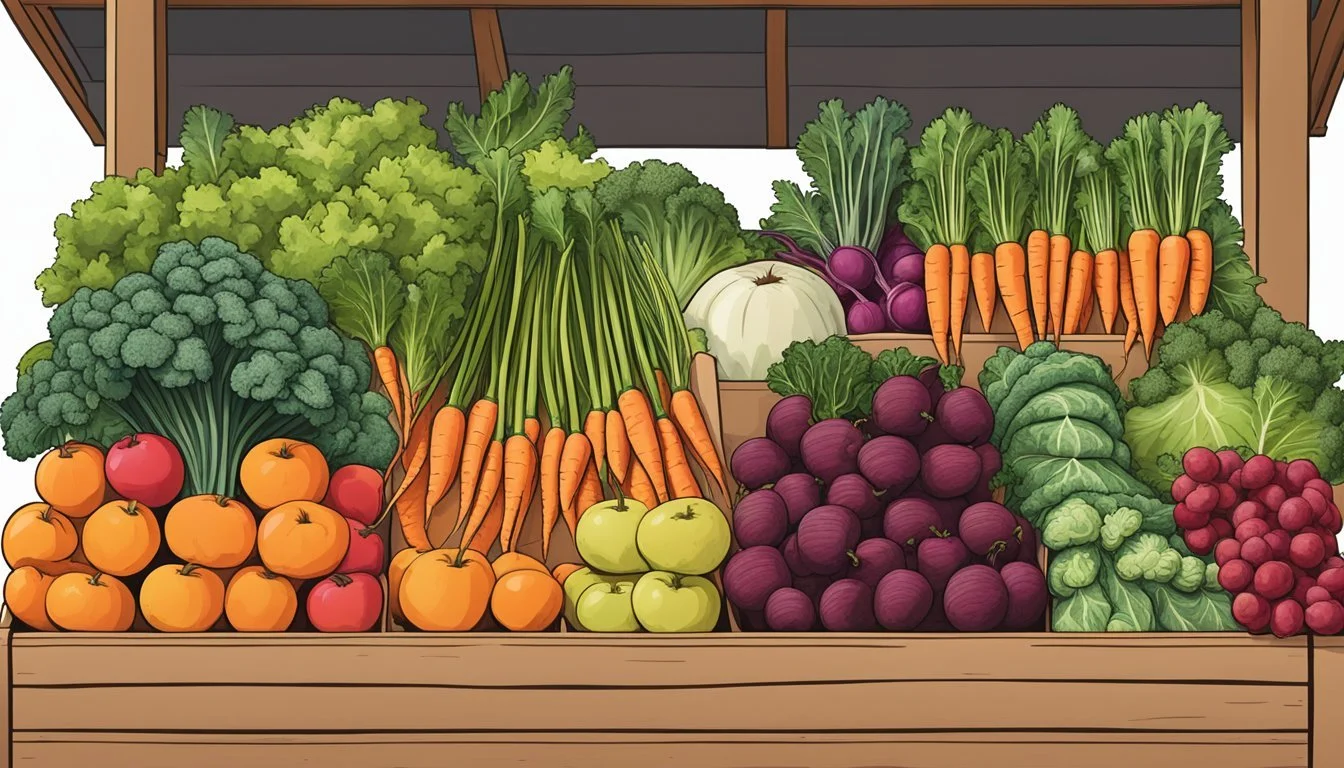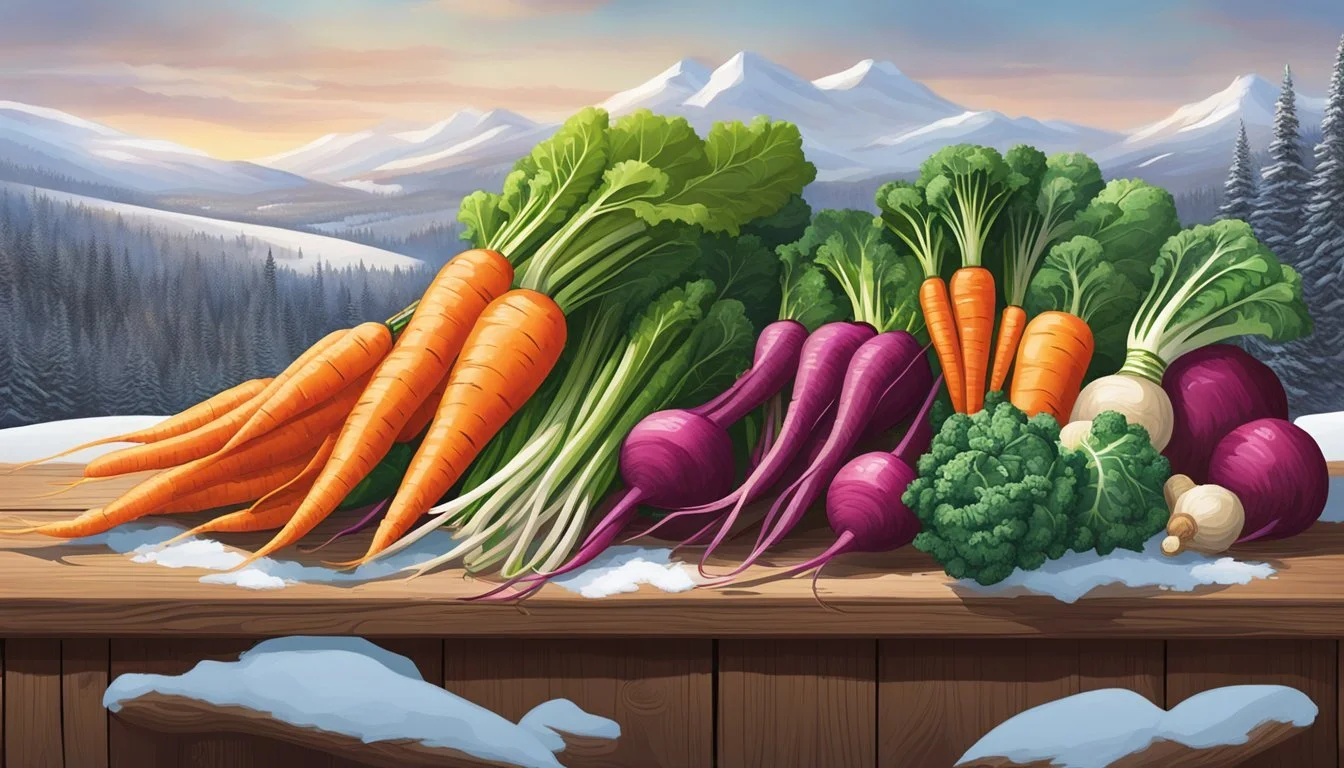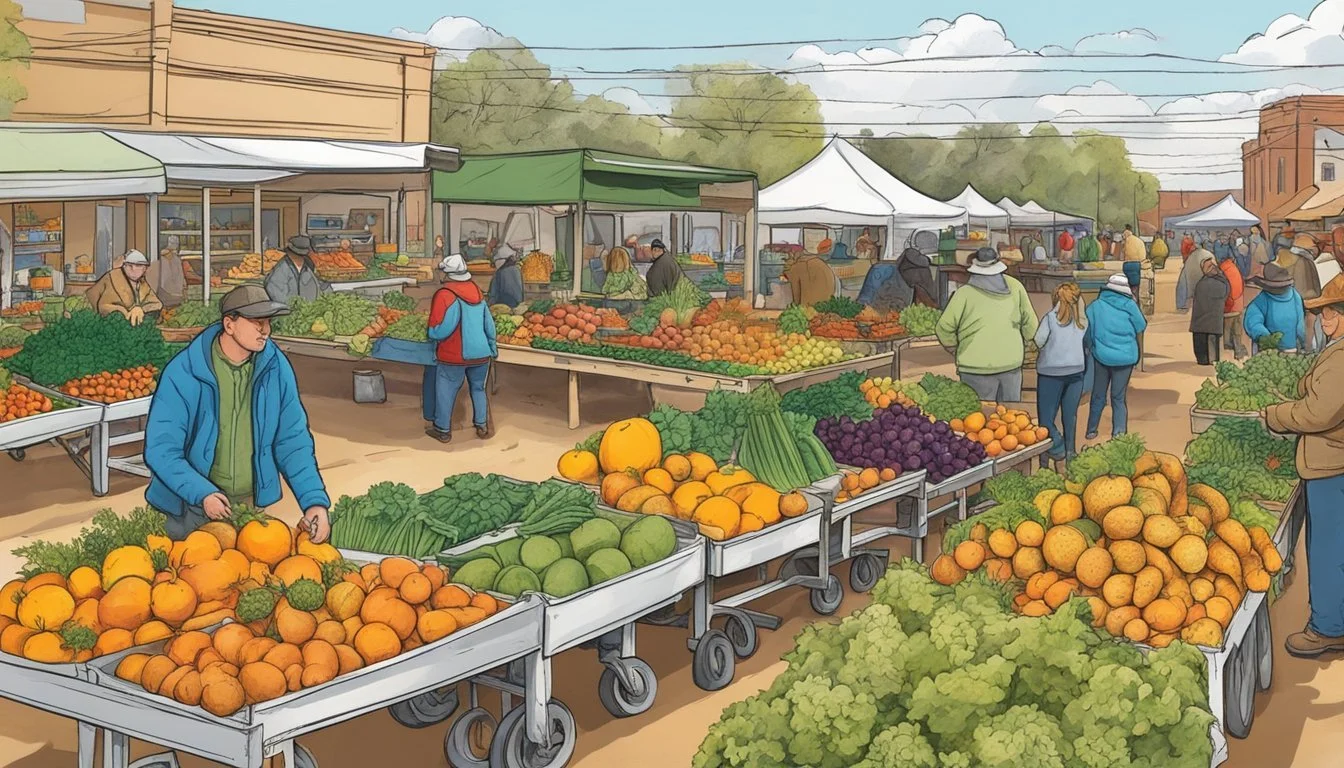Oklahoma Seasonal Fruit & Vegetables in January
Your Fresh Guide
This Article is Part of our Oklahoma Seasonal Fruit & Veg Calendar
In the heart of winter, Oklahoma's agriculture persists, offering a variety of fruits and vegetables that are in season in January. Despite the cooler temperatures, certain crops thrive during this time, providing fresh and flavorful produce to those looking for locally-grown options. The seasonal offerings are shaped by the state's unique weather conditions, which can affect the harvest window and availability of specific items.
Consumers seeking to support local farmers and enjoy produce at its peak can find a selection of goods that are traditionally harvested in the colder months. Root vegetables, such as turnips and radishes, and hearty greens, like kale (What wine goes well with kale?) and collards, are often available due to their tolerance of frost and cold soil conditions. Indoor growers and greenhouses also contribute to the winter produce selection, allowing for fresh herbs and other delicate items to be accessible.
While the winter harvest may not be as abundant as the peak seasons of spring and summer, Oklahoma's January produce provides an opportunity for nutritious and sustainable eating. It encourages culinary creativity with seasonal varieties that benefit from the state's winter climate, ensuring produce is both fresh and flavorful.
Understanding Seasonality in Oklahoma
In Oklahoma, the concept of seasonality is deeply influenced by the state's varied climate. The weather patterns oscillate from hot, humid summers to cold, dry winters, with transitional springs and falls. The seasonal shifts are important for agriculturists and consumers alike, as they significantly determine the availability of fresh produce throughout the year.
January falls firmly within Oklahoma's winter months. During this time, farmers contend with the challenges posed by cooler temperatures and fewer daylight hours. Despite these conditions, some hearty vegetables manage to thrive.
The fall season, generally spanning from July to October, is traditionally celebrated for its bountiful harvest, particularly for crops like apples, which reach peak ripeness. However, by the time winter arrives, the selection of fresh local produce starts to wane, with the remaining yields often comprised of winter-hardy produce.
Here is a snapshot of typical produce availability in January:
Vegetables:
Beets
Broccoli (how long does broccoli last?)
Cabbage
Cauliflower (how long does cauliflower last?)
Fruits: Limited availability; stored apples or imports are common
It's also important to note that unpredictable weather patterns can shift the typical harvest periods. This reality urges flexibility in both cultivation and consumption. Consumers seeking seasonal produce during Oklahoma's winter might turn to preserved or stored goods, such as canned vegetables and fruits, to supplement the reduced variety of fresh options.
Key Seasonal Fruits Available in January
January in Oklahoma welcomes a variety of fruits that hit peak ripeness, offering vibrant flavors that stand out during the winter season.
Citrus Fruits
Citrus fruits thrive in January's cool temperatures. They are known for their refreshing taste and are rich in vitamin C.
Oranges: A sweet and juicy selection, oranges are at their prime in January.
Lemons: These tart fruits add a bright flavor to any dish and are especially ripe during this month.
Apples
Apples, harvested in the fall, maintain their crispness and sweet flavor well into the winter months when stored correctly.
Fuji apples: These apples are known for their firm texture and sweetness.
Pears
Pears are another fruit that, after being picked in late autumn, can be enjoyed throughout January.
Bartlett pears: They have a classic pear flavor and become perfectly soft and juicy when ripe.
Key Seasonal Vegetables Available in January
In January, Oklahoma's cooler temperatures are suitable for a variety of seasonal vegetables. These include an assortment of root vegetables and leafy greens, as well as various members of the cruciferous family. Each category offers fresh produce that is both nutritious and flavorful during this winter month.
Root Vegetables
Root vegetables thrive in the cold, and January sees a good harvest of these subterranean treasures in Oklahoma. Key root vegetables include:
Radishes: Often requiring spacing for optimal growth, they are a crunchy option for salads and side dishes.
Carrots: Known for their sweetness and versatility, carrots can be used in both savory and sweet dishes.
Leafy Greens
Leafy greens flourish in the cooler climates and are a staple in winter diets for their nutrition:
Kale: A hearty green full of nutrients, kale is perfect for salads, soups, and as a cooked side.
Spinach: This tender green is rich in iron and can be eaten raw or cooked, offering flexibility in various recipes.
Cruciferous Vegetables
The cruciferous vegetable family, known for their health benefits, peaks in winter:
Cabbage: An excellent source of vitamins and fiber, cabbage is versatile, used in salads, soups, and ferments like sauerkraut (how long does sauerkraut last?).
Broccoli: High in vitamins C and K, broccoli can be enjoyed steamed, roasted, or raw.
Cauliflower: Its mild flavor allows for varied culinary uses, from roasting to being processed into a rice substitute.
These vegetables represent a fraction of the seasonal bounty available in Oklahoma in January, providing fresh options for a healthy start to the year.
Harvesting and Storage Tips
In the variable climate of Oklahoma, January is not the peak season for fresh produce, yet it remains crucial for gardeners to apply proper harvesting and storage methods to extend the longevity of any available fruits and vegetables.
Fruit Harvesting Tips
Gardeners should harvest fruits such as apples or pears, which can linger into winter, using pruners for a clean cut that doesn't harm the tree. They need to select fruits that are firm and free from pests or decay. Once harvested, fruits should be stored at cool temperatures. For example, apples store well at 32-40°F with moderate humidity to prevent shriveling.
Vegetable Harvesting Tips
Vegetables like kale and collards may still be viable in January and should be picked only when fully mature to maximize storage life. Root vegetables such as turnips and beets can often withstand the colder temperatures and should be harvested gently to prevent bruising. They benefit from storage in a dark, cool place, ideally in a root cellar at temperatures just above freezing. Vegetables should be dry and free of soil to reduce the risk of spoilage.
Winter-Friendly Recipes
In Oklahoma, the chilly month of January offers a bounty of seasonal produce that can be transformed into comforting and nourishing meals. Utilizing vegetables like kale, broccoli, and squash, as well as fruits such as lemons and oranges, chefs can concoct a range of winter-friendly recipes that are both hearty and healthy.
Stews and Soups:
A staple during winter, stews brim with nutrients and flavors, particularly when made with January's seasonal vegetables. For example, a Hearty Winter Vegetable Stew might include:
Kale
Broccoli
Cauliflower
Carrots
Onions
Garlic
Citrus-Infused Dishes:
Citrus fruits like lemons contribute a vibrant, tangy note to dishes. They can be incorporated into recipes in various forms, from zesty dressings to bright marinades. A popular recipe is:
Lemon Herb Roasted Chicken (What wine goes well with roasted chicken?) with:
Lemon slices
Fresh herbs
Root vegetables
Roasted Vegetables:
Roasting vegetables such as winter squash and sweet potatoes caramelizes their natural sugars, enhancing their flavor. They can be served as a side dish or integrated into a main course, like:
Roasted Root Vegetable Medley
Sweet Treats:
Seasonal fruits also play a role in desserts. A Strawberry Coffee Cake stands as a delightful indulgence, pairing nicely with the bold flavors of January produce.
When crafting recipes using January's freshest picks in Oklahoma, one can rely on the robust flavors of these produce items to create food that warms the body and the spirit. Each recipe honors the seasonal availability of fruits and vegetables, ensuring that every meal is both delicious and attuned to the winter season.
Gardening and Growing Tips
In Oklahoma, January is a pivotal month for gardening enthusiasts, setting the foundation for a successful spring harvest. Gardeners should focus on soil preparation and leveraging indoor and winter gardening techniques during this cooler period.
Indoor Gardening
Gardeners can begin by starting certain vegetables indoors. The soil used for indoor planting should be a well-draining potting mix free of outdoor soil pathogens. They can sow lettuce varieties, such as Butterhead and Loose Leaf, which are suitable for transferring outdoors after the last frost. Starting seeds indoors not only gives a head start to the growing season but also protects young plants from harsh winter conditions.
Key indoor gardening steps:
Select: Choose appropriate container sizes for different vegetables.
Sow: Plant seeds at the proper depth according to seed packet instructions.
Maintain: Keep the soil consistently moist and provide sufficient light.
Winter Gardening
For winter gardening outdoors, gardeners should select cold-hardy vegetables that can withstand January’s lower temperatures. Vegetables like spinach, radishes, and turnips can tolerate frost and can be planted directly into the garden. Ensuring that the soil remains unfrozen is crucial, so adding a layer of mulch for insulation can be beneficial.
Winter gardening tips:
Prepare the Soil: Before the ground freezes, incorporate compost to enrich the soil.
Mulch: Apply a thick layer of mulch to protect plants from freezing temperatures.
Water: Provide sufficient water, as winter precipitation may not be adequate.
By following these tips, Oklahoma gardeners can effectively navigate the challenges of January gardening to ensure a robust harvest in the coming seasons.
Shopping for Seasonal Produce
January in Oklahoma offers a vivid tableau of fresh produce that is both flavorful and nutritious. Knowing where to shop can enhance the quality and variety of selections available.
Local Farmers' Markets
In Oklahoma City and many other urban areas in the state, local farmers' markets are prime spots for the freshest seasonal produce. Shoppers frequently find hearty greens like kale and a variety of cruciferous vegetables, which are aplenty during January. These venues often boast more than just produce; they serve as a community hub where one can find local honey, homemade preserves, and artisanal breads that complement the fresh fruits and vegetables.
What to look for at Farmers' Markets:
Kale
Broccoli
Brussels Sprouts (how long do brussels sprouts last?)
Cabbage
Grocery Store Selections
Grocery stores across Oklahoma maintain a selection of fresh produce year-round. In January, their offerings include both in-state produce and items from other regions to ensure a wide variety. Citrus fruits, for example, may be sourced from warmer climates to guarantee freshness and taste. Shoppers can expect selections to be plentiful, with many stores providing organic options.
Typical Grocery Store Offerings in January:
Citrus Fruits - oranges, lemons, and grapefruits
Root Vegetables - carrots, turnips
Leafy Greens - spinach, lettuces
Grocery store chains and local stores alike prioritize the availability of fresh, seasonal produce to meet consumer demand for quality and flavor.
Nutritional Benefits of Seasonal Produce
Eating seasonal produce is highly beneficial for one's health due to the fresh fruits and vegetables that contain a higher nutrient profile when harvested at the peak of their freshness. These nutrients are crucial for maintaining the body's health, providing a range of vitamins, minerals, and antioxidants.
Fruits and vegetables available in January in Oklahoma, like kale and Brussels sprouts, are rich in dietary fiber, which aids in digestion and can contribute to heart health. They also provide essential vitamins such as vitamin C, important for immune system function, and vitamin K, which plays a role in bone health and wound healing.
A common fruit harvested in winter, apples, come in various types that are high in antioxidants. These substances help combat oxidative stress and may reduce the risk of chronic diseases such as cancer and heart disease.
Nutrient composition of seasonal produce may vary, but they often contain:
Vitamins (A, C, E, K, and B complex)
Minerals (potassium, magnesium, calcium)
Phytonutrients (flavonoids, polyphenols)
Consuming a diet rich in these nutrients can lead to better health outcomes. Seasonal fruits and vegetables can:
Strengthen the immune system
Reduce inflammation
Help regulate blood sugar
Promote healthy skin and eyes
In conclusion, incorporating a variety of seasonal fruits and vegetables into one's diet can offer a multitude of nutritional benefits, supporting overall health and well-being.
Impacting Local Economy and Environment
In the heart of the United States, Oklahoma's commitment to its local economy and environment is evident through its support of seasonal fruit and vegetable production. The cultivation of these seasonal commodities provides a financial backbone for many small-scale farmers, with entities like the Oklahoma Council highlighting the considerable income potential from high-value crops.
Local Economy:
By choosing seasonal produce, consumers are investing in the state's economy. Money spent on local produce is more likely to circulate within the state, providing economic resilience. Small family farms flourish when local demand increases, thereby creating jobs and nurturing community development.
Environmental Stewardship:
Focusing on seasonal produce grown in Oklahoma reduces the carbon footprint associated with long-distance transportation. 'Green Oklahoma' underscores the benefits of consuming locally produced food, which includes a diminished environmental impact. Engaging in strategies that promote sustainable farming practices further aids in this effort.
Sustainable Practices:
Oklahoma farmers are encouraged to adopt sustainable methods of production that are not only profitable but also environmentally sound. These practices make the most of the state’s diverse soil types and weather conditions, as indicated by the USDA, allowing for resilience against changing climates.
Here is how the local production of seasonal fruits and vegetables impacts Oklahoma:
Economic Impact:
Empowers local farmers
Keeps money within the state
Supports family-owned businesses
Boosts local job creation
Environmental Benefits:
Reduces transportation emissions
Encourages sustainable land use
Decreases reliance on non-renewable resources
Promotes biodiversity through various crop rotations
The synergy between the local economy and the environment in Oklahoma is tangible. It paves the way for a sustainable future while solidifying the state's economic standing.











